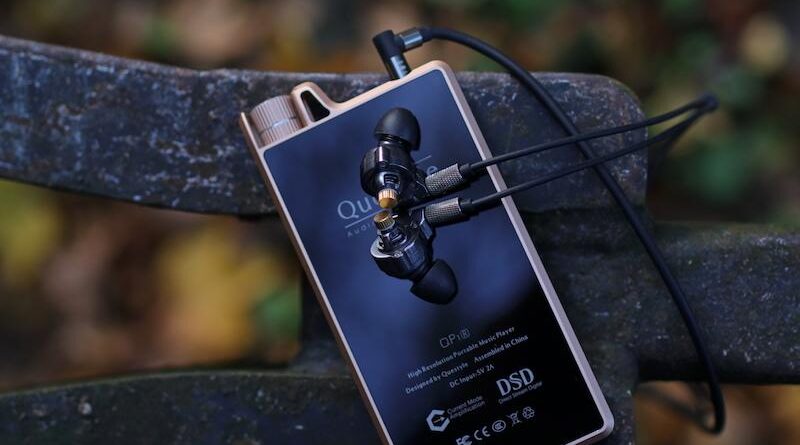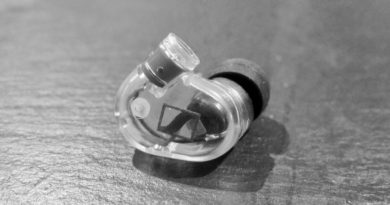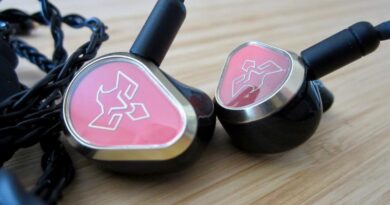Questyle QP1R Review – Welcome In!
The $899 Questyle QP1R is one of those very few products that go beyond the expectation built around them – which is double as significant if I consider I was spoken quite highly of it before acquiring it. This article is about my practical experience with it, and why it will very likely stay as a cornerstone of my audiophile infrastructure for quite a long while I reckon.
In this Article
At-a-glance Card
| PROs | CONs |
| High end DAC competence featuring top clean, detailed, micro-dynamized analog-timbred presentation | Prehistoric-age UI / UX |
| Class-A amplifier operations delivering spectacular sound quality | Buggy battery status indication and EQ modules |
| Proprietary Current Mode Amplification technology yielding superior biasing competence on IEMs including high demanding ones | Very limited connectivity features |
| Crystalline quality coax/optical line out option | Unenticing battery autonomy |
| Dual TF card support |
Do I need a DAP?
Audio life after owning an Apogee Groove becomes a bit more complicated in a sense. Do I want to go back to lower quality output, even in exchange for better portability, or more collateral features?
The question actually admits more answers than it might seem at first tought, in consideration of what one really wants or needs.
In my specific case I don’t commute on my way to/from work for one. Also, I currently suspended all business travel due the pandemic and it will take quite longtime before I resume that. My job doesn’t allow me to listen to music while working. For all these reasons I’m sharply inclined to get the real best audio quality out of the always-too-short-time I can dedicate to music listening, which most frequently happens in a quite, controlled space such as at home, in the evenings, or at work, during lunchbreak, or few other instances.
So in short: while at home Apogee Groove it is. What else? If something, I might need to add a desktop amp to that but that’s another story. But no need for a DAP at home, really.
How about on the go?
Well… Apogee Groove is a relatively power-demanding battery-less dac-amp, a “fat dongle” I might call it, and as such a still quite compact and lightweight thing. So option #1 for mobile use is… still the Groove! Wherever my laptop can follow me, that’s a very viable option, the main one really.
How about something actually pocketable? Like a DAP, in facts.
I used to own an Hiby R5 but that’s not an option anymore. Don’t take me wrong, I still believe R5 is worth its money as a complete device – mostly due to its huge feature set, connectivity, etc, all at a reasonably moderate price. It’s just me: simply put, I grew past it. Sound quality off the Groove is just so uncomparably better I just can’t listen to something so obviously less clean, resolved, detailed, and musical anymore.
So I sold the R5. The guy who grabbed it from ebay scored a good deal, I tell ya.
And before you ask: no, I still do prefer not to use my phone as an all-in-one device. I use the smartphone as a phone and an internet device and I prefer to keep it as is. Also, I don’t really care about Tidal or other subscription based music streaming service, as most of the music I like is not there anyway, which takes away a very solid reason to a smartphone being directly or indirectly involved in the game. I’m not there, no.
It needs to be a(nother) DAP.
Not the tinyest, I don’t care about ultra-pocketablity – I’m a couch potato, I don’t go jogging or gymming anyway.
Not the widest connected either – see above.
It “just” needs to sound superbly well while playing lossless hires “stuff” from local TF cards. For as little as it seems, this is not easy – if the minimum reference is a Groove. As a matter of facts I auditioned quite a few mainstream brand (Hiby, Shanling, Fiio) models in the sub-€1000 arena. Nothing good for my “new” tastes there.
Then I followed a friend’s rec, and I eyed a recently discontinued model by a chinese manufacturer of higher-end equipment: Questyle. After some watching around I eventually landed a good deal on a pre-loved QP1R unit, a model originally released back in 2015. A very well cared-of sample in spite of its 4 years of age… and here I am.
What the … !
It takes 10 seconds listen to determine that sound-wise QP1R runs circles around all other “chifi” DAPs I ever tried. Double-circles, actually, around my previous R5.
For almost everything else – usability, connectivity, features – instead, the exact opposite is the case. But let’s keep this for later.
Sound reconstruction superiority vs low and mid-tier chifi DAPs is so huge that comparing QP1R to them seems by and large inappropriate, useless and misleading. The difference in terms of clarity, detail, stage, imaging is gigantic. QP1R’s DAC belongs to a totally different quality league, period.
From the DAC performance standpoint, the cheapest DAP device I auditioned which I can honestly call comparable to QP1R is Lotoo Paw 6000. A much cheaper one – Sony NW-A55, upgraded with Mr Walkman’s firmware – is not playing in the same ballpark with QP1R, yet solidly in the one just below. All other “usual suspects” fall instead into the just-forget-about-this category, in comparison.
Taking DAC-AMP devices in considerations, I’d say QP1R comes accross almost as clean and similarly musical compared to Apogee Groove, which still has the lead in terms of spatial drawing though.
QP1R is also detailing approximately at Chord Mojo level. Another similarity vs Mojo is on tonality, which is warm-ish.
QP1R sound is clean, impactful, detailed but most of all unbelievably dynamic. Amongst all its numerous positive sound features micro dynamism is no doubt QP1R’s most stunning and possibly unique point. After auditioning devices 5 times its historical list price I still have to find something “really” superior on that aspect.
“Musicality” is also a very evident feature of QP1R voicing, and that’s an effect that comes out even a tad more evident than from the Groove, and that’s saying something.
QP1R reconstruction filter’s ringing envelope is quite elongated after the pulse. That’s the origin for its mellow timbre.

Someone labelled that “analogue”, which in lack of more precise wordage I feel can give a good hint into what I’m trying to convey. Going back to Mojo, that is by comparison edgier – not sharply and offensive overall, it never is, I’m just saying relative to QP1R or Groove – thus offering a “higher detailing sensation”.
Also, Mojo’s very special ability on closing the sound level gap between front and back sound lines by comparison makes the latter on QP1R come through as less loud and therefore detailed. This is Mojo’s kinda unique specialty though, not the other way around.
In terms of spatiality QP1R is I’d say on par with the Mojo, which is good, miles better than more ordinary devices, although still quite a pretty step south of Groove’s totally special capacity to render the impalpable sensation of the actual stage size. I’ll have to live with that I’m afraid.
Current Mode Amplification
What I described until now is mainly QP1R’s capabilities as a DAC.
Oh by the way: a very nice feat is also QP1R’s line out option. By just connecting a 3.5mm cable into it the device automatically switches into Line Out mode (1.9V RMS), no need to click/tap any options in the GUI – very handy! Also, the port itself is a multi-mode port: it accepts both copper and optical connections, depending on the adapter which is being used.
Coming to the headphone output option, QP1R only offers single-ended connectivity. Its superior quality nudges me to give justice to those more expert than me who noted “you’ll find balanced output better than single ended only until you’ll start attaining higher-tier devices, where single ended output is implemented competently enough in the first place”. Balanced topology, in other words, is often adopted on mobile and/or budget-tier devices to partially overcome some structural limitations, so to say, and it becomes way less important once you build the foundation better from day one.
Fact is: QP1R 3.5mm phone out sounds lovely. Clean and transparent in respect to what its internal DAC module is offering, and superbly competent in coping even with the most capricious IEMs on the opposite end.
Of course by sound cleanness I’m not referring to lack of audible background noise, which is kind of obvious and after all quite common, even on lower tier devices. Clean sound decodes into QP1R’s ability to pass the whopping soundstage expansion and spectacular separation and imaging which the DAC module is capable of along to the drivers, unharmed.
This is certainly due to its well engineered class-A amp module, adopting Questyle’s own proprietary (and patented) technology called Current Mode Amplification. A description can be found here: https://www.questyle.com/en/technology. It’s an interesting read, I do recommend you take it.
These are the official specs:
| Gain = High Max Output Amplitude: Vout=1.9V rms Output Power: 40mW@32Ω | Gain = Middle Max Output Amplitude: Vout=1V rms Output Power: 31mW@32Ω | Gain = Low Max Output Amplitude: Vout=0.53V rms Output Power: 8.8mW@32Ω |
Output Impedance: 0.15 Ω
Apart for the very low Output Impedance, which is of course a major plus when dealing with IEMs, these output power figures appear nothing less than “ridiculous” (8,8mW on a 32Ω load??) compared to those of many low end daps, and of some phones too.
Nothing could be more misleading. I frequently rotate a total of 7 different IEMs on QP1R and the sole one which hints me to choose Mid gain is – you guessed it – final E5000. All the others are perfectly & fully dynamically driven by Low gain.
As too few people still know, an amp’s cability is not even remotely completely described by its “(milli) Watts” power figure. I won’t write a treaty here. Long story short: headphones (all of them) require current to make their transducers vibrate and produce sound. High impedance drivers require relatively little current, but higher voltages to work best. Low (sub 32 Ohm) impedance drivers – like those inside IEMs – require more current in comparison and they must be applied very low voltages to work best (or at all!). QP1R’s Continuous Current Drive technology is designed to deliver the right “form” of amplification to the various different drivers, with particular regards to low impedance ones.
While I’m at it, High Gain is the least desireable option on QP1R: dynamic range is perceivably contracted there, so it’s good that it turns out not to be vital to exploit it, at least for my selected drivers’ range. Luckily, I encountered no IEM (yes, planars included) really requiring High Gain from QP1R.
Everything else
All of the above said about sound, QP1R is – simply put – the antithesis of modernity and convenience in terms of connectivity, features and ergonomics. On all these counts, it’s actually a fossil if there’s one, let’s say it clearly.
Connectivity:
- No Wifi: so forget OTA upgrades, DLNA access to servers, Tidal, Qobuz etc
- Outdated BT, and exclusively dedicated to TWS driver connectivity
- USB DAC-IN available: QP1R can be connected to a USB host and be used as an external DAC-AMP
- No digital output (not even USB DAC-OUT) available
- No analog input available
- 3.5mm single ended phone output
- 3.5mm multi-mode (Coax/Toslink) line out
Storage
- Internal memory. Capacity depends on model release. My unit has 32GB available. USB connection to a PC is required to read/write files on that partition, at an incredibly sluggish, turtle-level speed, too.
- Dual TF card. Officially supporting 128GB cards, I could successfully use 512GB cards though. Database reconstruction after card swap is quite fast, at least that.
UI / UX and sw features
- Calling it primitive is making a big and honeestly undeserved compliment.
- No touch screen
- An infuriatingly badly engineered scrollwheel (where’s my iPod1?)
- A totally buggy visual battery charge indicator (even on latest firmware)
- Very limited Graphical EQ capabilities, and not well working either
- No Parametric EQ nor any other sound shaping features
Battery
- Dramatically undersized
- No more than 8 hours autonomy (with a brand-new battery…)
- A short sleep timeout setting is recommended, as the Class-A amp will equally consume juice while playing or not…
Conclusions
QP1R sounds unbelievably good. I extended the most sincere thanks to the friend who recommended it to me. He anticipated I would find it good, indeed I found it much more than good.
QP1R sound is nothing short than gorgeous. It’s clean, detailed, extended, musical. It also features a quite unique “analogue” timbre. In terms of amping it supports all low or moderate impedance loads I tried on it with the sole exception of my Shure SRH1540 – which are a bad client per se honestly.
Stunning sound quality apart, as I mentioned above pretty much all the rest … requires a lot of patience! QP1R is a sort of dinosaur, pretty much that.
I was looking for a no-compromise, higher-end-sounding DAP at a still reasonably affordable price, and that’s what I got. QP1R delivers that, only that, and I’m totally fine with it.
Disclaimer
Bought it myself.
Our generic standard disclaimer.
You find an INDEX of our most relevant technical articles HERE.











